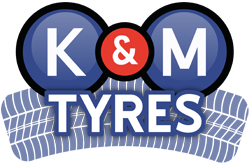 There is a bit of a misconception in the UK that winter tyres or cold weather tyres are not necessary for the winter conditions that we experience here. However, this couldn’t be further from the truth, as these tyres become really effective when temperatures go below 7 °C. And temperatures often go lower than this. Winter brings a number of hazards including rain, snow, wet leaves and black ice. The fitting of winter tyres will improve the safety of your vehicle in these conditions. The special tread patterns of these specially designed tyres means they perform better in more extreme conditions. In this article from K&M Tyres based in Crowborough, we look at what winter tyres are, how they work, the legal requirements and their pros and cons.
There is a bit of a misconception in the UK that winter tyres or cold weather tyres are not necessary for the winter conditions that we experience here. However, this couldn’t be further from the truth, as these tyres become really effective when temperatures go below 7 °C. And temperatures often go lower than this. Winter brings a number of hazards including rain, snow, wet leaves and black ice. The fitting of winter tyres will improve the safety of your vehicle in these conditions. The special tread patterns of these specially designed tyres means they perform better in more extreme conditions. In this article from K&M Tyres based in Crowborough, we look at what winter tyres are, how they work, the legal requirements and their pros and cons.
What are winter tyres?
Winter tyres are designed for use when temperatures are low and the roads are slippery and shouldn’t be confused with snow or ice tyres. They are designed to provide more traction and grip. When combined with the added advantage of more efficiency at clearing standing water, they will keep you safer on the roads when it’s raining. They will also be more effective than summer tyres in snow and ice.
How do winter tyres work?
There are several major differences when comparing them with summer tyres.
- More grooves on the tread pattern – displace water and give more grip in ice and snow
- Greater tread depth – normally between 8-9cm
- More silica in the tyre compound – stay soft and supple in freezing temperatures improving grip
- Designed to vibrate when moving – any snow is shaken off
Legal requirements regarding the fitting of tyres designed for winter conditions
Currently, there is no legal requirement in the UK to fit these tyres although in several European countries, it is mandatory. Generally winter tyres are fitted between October and March. It is also worth noting that some countries including Germany, Austria, Finland and Sweden demand that your vehicle is fitted with winter tyres if you are driving there.
Advantages
- Better grip in both wet and dry conditions
- Improved contact with the road
- Out perform summer tyres for traction, cornering and braking (Below 7 °C)
- Safer in snow and ice
- Reduced stopping distances
- Risk of skidding is lower
The only slight downside – you will need 2 sets of tyres
Winter tyres can prove a very good investment if you do a lot of driving or live in a remote or difficult to reach location. This could include living on a steep hill or your driveway having a steep incline. However, they are not suitable for all year round use, so you will need 2 sets of tyres. This means that you will have to factor in the cost of the tyres, and storing them, as they will need to be changed in the spring. It’s usually not necessary to advise your insurance company. However, it may be wise to just let them know, but it usually doesn’t affect your premium. They must be fitted to wheels of the correct specification. If you go to an approved and experienced tyre fitting service station, this will be a matter of course.
How K&M Tyres can help you stay safe on the road with winter tyres
K&M Tyres wants drivers to be as safe as possible on the roads and offers a FREE tyre safety check. We also have a selection of car tyres for winter driving conditions including the Discoverer Winter from Cooper Tires and the ultra-high performance Alpine/Studless Winter PCR from Roadstone. Why not call us on 01892 653131? Or you could pop into our service centre located on the Millbrook Industrial Estate opposite Plumbase in Crowborough, East Sussex. Our trained and experienced technicians will help you choose the best tyres for your vehicle according to your budget and help you to decide.



